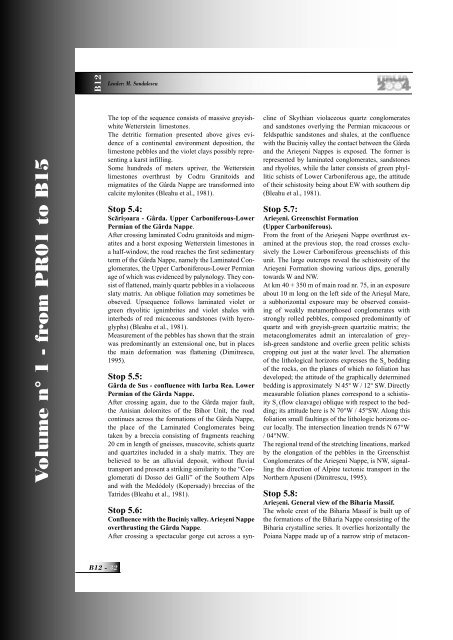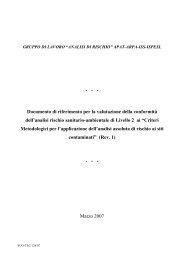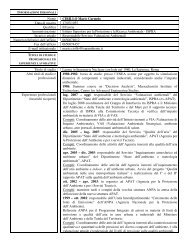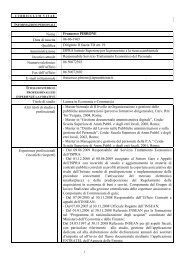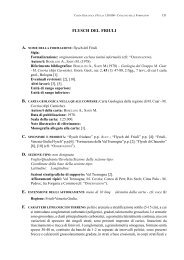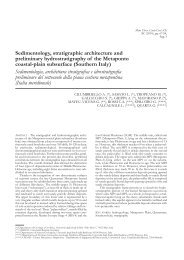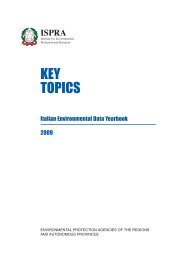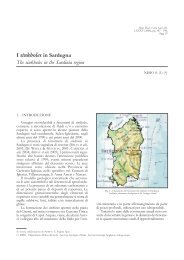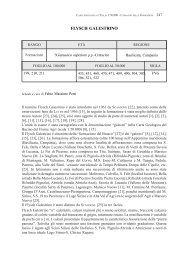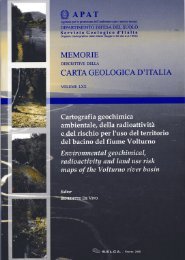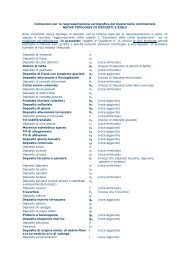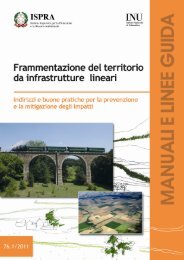Guidebook - Ispra
Guidebook - Ispra
Guidebook - Ispra
You also want an ePaper? Increase the reach of your titles
YUMPU automatically turns print PDFs into web optimized ePapers that Google loves.
Volume n° 1 - from PR01 to B15<br />
B12<br />
B12 -<br />
Leader: M. Sandulescu<br />
The top of the sequence consists of massive greyishwhite<br />
Wetterstein limestones.<br />
The detritic formation presented above gives evidence<br />
of a continental environment deposition, the<br />
limestone pebbles and the violet clays possibly representing<br />
a karst infilling.<br />
Some hundreds of meters upriver, the Wetterstein<br />
limestones overthrust by Codru Granitoids and<br />
migmatites of the Gârda Nappe are transformed into<br />
calcite mylonites (Bleahu et al., 1981).<br />
Stop 5.4:<br />
Scărișoara - Gârda. Upper Carboniferous-Lower<br />
Permian of the Gârda Nappe.<br />
After crossing laminated Codru granitoids and migmatites<br />
and a horst exposing Wetterstein limestones in<br />
a half-window, the road reaches the first sedimentary<br />
term of the Gârda Nappe, namely the Laminated Conglomerates,<br />
the Upper Carboniferous-Lower Permian<br />
age of which was evidenced by palynology. They consist<br />
of flattened, mainly quartz pebbles in a violaceous<br />
slaty matrix. An oblique foliation may sometimes be<br />
obseved. Upsequence follows laminated violet or<br />
green rhyolitic ignimbrites and violet shales with<br />
interbeds of red micaceous sandstones (with hyeroglyphs)<br />
(Bleahu et al., 1981).<br />
Measurement of the pebbles has shown that the strain<br />
was predominantly an extensional one, but in places<br />
the main deformation was flattening (Dimitrescu,<br />
1995).<br />
Stop 5.5:<br />
Gârda de Sus - confluence with Iarba Rea. Lower<br />
Permian of the Gârda Nappe.<br />
After crossing again, due to the Gârda major fault,<br />
the Anisian dolomites of the Bihor Unit, the road<br />
continues across the formations of the Gârda Nappe,<br />
the place of the Laminated Conglomerates being<br />
taken by a breccia consisting of fragments reaching<br />
20 cm in length of gneisses, muscovite, schists quartz<br />
and quartzites included in a shaly matrix. They are<br />
believed to be an alluvial deposit, without fluvial<br />
transport and present a striking similarity to the “Conglomerati<br />
di Dosso dei Galli” of the Southern Alps<br />
and with the Medódoly (Kopersady) breccias of the<br />
Tatrides (Bleahu et al., 1981).<br />
Stop 5.6:<br />
Confluence with the Buciniș valley. Arieșeni Nappe<br />
overthrusting the Gârda Nappe.<br />
After crossing a spectacular gorge cut across a syn-<br />
cline of Skythian violaceous quartz conglomerates<br />
and sandstones overlying the Permian micaceous or<br />
feldspathic sandstones and shales, at the confluence<br />
with the Buciniș valley the contact between the Gârda<br />
and the Arieșeni Nappes is exposed. The former is<br />
represented by laminated conglomerates, sandstones<br />
and rhyolites, while the latter consists of green phyllitic<br />
schists of Lower Carboniferous age, the attitude<br />
of their schistosity being about EW with southern dip<br />
(Bleahu et al., 1981).<br />
Stop 5.7:<br />
Arieșeni. Greenschist Formation<br />
(Upper Carboniferous).<br />
From the front of the Arieșeni Nappe overthrust examined<br />
at the previous stop, the road crosses exclusively<br />
the Lower Carboniferous greenschists of this<br />
unit. The large outcrops reveal the schistosity of the<br />
Arieșeni Formation showing various dips, generally<br />
towards W and NW.<br />
At km 40 + 350 m of main road nr. 75, in an exposure<br />
about 10 m long on the left side of the Arieșul Mare,<br />
a subhorizontal exposure may be observed consisting<br />
of weakly metamorphosed conglomerates with<br />
strongly rolled pebbles, composed predominantly of<br />
quartz and with greyish-green quartzitic matrix; the<br />
metaconglomerates admit an intercalation of greyish-green<br />
sandstone and overlie green pelitic schists<br />
cropping out just at the water level. The alternation<br />
of the lithological horizons expresses the S 0 bedding<br />
of the rocks, on the planes of which no foliation has<br />
developed; the attitude of the graphically determined<br />
bedding is approximately N 45° W / 12° SW. Directly<br />
measurable foliation planes correspond to a schistisity<br />
S 1 (flow cleavage) oblique with respect to the bedding;<br />
its attitude here is N 70°W / 45°SW. Along this<br />
foliation small faultings of the lithologic horizons occur<br />
locally. The intersection lineation trends N 67°W<br />
/ 04°NW.<br />
The regional trend of the stretching lineations, marked<br />
by the elongation of the pebbles in the Greenschist<br />
Conglomerates of the Arieșeni Nappe, is NW, signalling<br />
the direction of Alpine tectonic transport in the<br />
Northern Apuseni (Dimitrescu, 1995).<br />
Stop 5.8:<br />
Arieșeni. General view of the Biharia Massif.<br />
The whole crest of the Biharia Massif is built up of<br />
the formations of the Biharia Nappe consisting of the<br />
Biharia crystalline series. It overlies horizontally the<br />
Poiana Nappe made up of a narrow strip of metacon-


